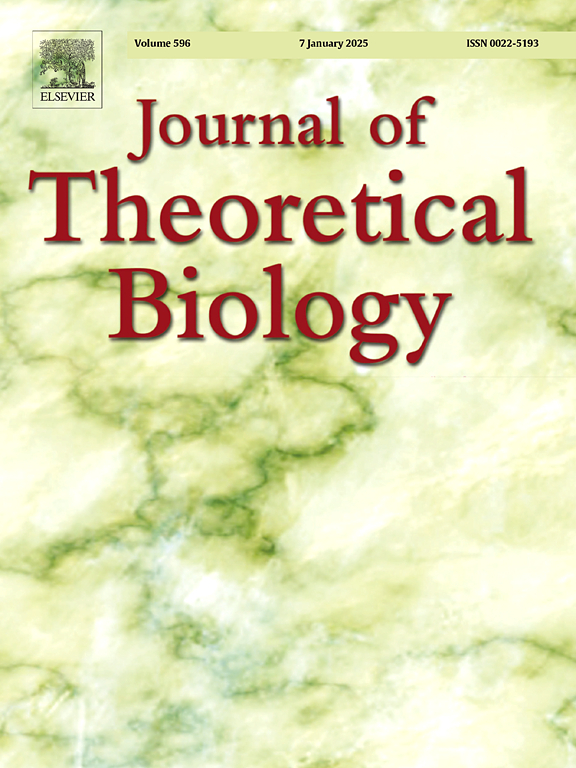分支结构影响单个树内的遗传多样性。
IF 1.9
4区 数学
Q2 BIOLOGY
引用次数: 0
摘要
当一棵树生长多年时,体细胞突变积累起来,在单个树枝之间形成遗传变异。树木可以将这种突变传递给后代,从而潜在地增强种群的遗传多样性。我们研究了一个数学模型来理解个体内遗传变异和分支结构之间的关系。我们通过向每个终端分支(母分支)重复添加两个新分支(主分支和横向子分支)来生成分支架构。该建筑的特点是两个关键参数:主侧比(ML)和儿母比(DM)。在枝条伸长过程中,体细胞突变在枝条顶端的茎尖分生组织(shoot apical merisystem, SAM)的干细胞中积累。在分支中,所有的干细胞都从母体传递到主子分支,但只有一个干细胞被选择用于侧子分支。我们通过Z¯来评估遗传变异,即一棵树上所有对分支之间的平均遗传差异,并在保持总分支长度不变的情况下,研究Z¯如何随DM和ML变化。结果表明:(1)Z¯随ML单调增加;(2)当SAM中的干细胞在基因上是同质的时,中间DM的Z¯达到最大值;(3)干细胞异质时,Z¯随DM单调减小。分支结构的影响取决于SAM内的遗传异质性,这是干细胞在生长过程中的行为造成的。我们的研究揭示了分支结构在储存遗传多样性中被忽视的作用。本文章由计算机程序翻译,如有差异,请以英文原文为准。
Branching architecture affects genetic diversity within an individual tree
While a tree grows over many years, somatic mutations accumulate and form genetic variation among branches within an individual. Trees can transmit such mutations to subsequent generations, potentially enhancing the genetic diversity of the population. We study a mathematical model to understand the relationship between within-individual genetic variation and branching architecture. We generate branching architecture by repeatedly adding two new branches (main and lateral daughter branches) to each terminal branch (mother branch). The architecture is characterized by two key parameters: main-lateral ratio (ML) and daughter-mother ratio (DM). During branch elongation, somatic mutations accumulate in the stem cells of a shoot apical meristem (SAM) at the tip of each branch. In branching, all the stem cells are passed on from the mother to the main daughter branch, but only one stem cell is chosen for the lateral daughter branch. We evaluate genetic variation by , the mean genetic differences between all pairs of branches of a tree, and examine how varies with DM and ML while keeping the total branch length constant. As a result, (1) increases monotonically with ML; (2) attains the maximum for an intermediate DM, when stem cells in a SAM are genetically homogeneous; (3) decreases monotonically with DM when stem cells are heterogeneous. The effect of branching architecture varies significantly depending on the genetic heterogeneity within a SAM, which results from the behavior of stem cells during growth. Our study sheds light on the overlooked role of branching architecture in storing genetic diversity.
求助全文
通过发布文献求助,成功后即可免费获取论文全文。
去求助
来源期刊
CiteScore
4.20
自引率
5.00%
发文量
218
审稿时长
51 days
期刊介绍:
The Journal of Theoretical Biology is the leading forum for theoretical perspectives that give insight into biological processes. It covers a very wide range of topics and is of interest to biologists in many areas of research, including:
• Brain and Neuroscience
• Cancer Growth and Treatment
• Cell Biology
• Developmental Biology
• Ecology
• Evolution
• Immunology,
• Infectious and non-infectious Diseases,
• Mathematical, Computational, Biophysical and Statistical Modeling
• Microbiology, Molecular Biology, and Biochemistry
• Networks and Complex Systems
• Physiology
• Pharmacodynamics
• Animal Behavior and Game Theory
Acceptable papers are those that bear significant importance on the biology per se being presented, and not on the mathematical analysis. Papers that include some data or experimental material bearing on theory will be considered, including those that contain comparative study, statistical data analysis, mathematical proof, computer simulations, experiments, field observations, or even philosophical arguments, which are all methods to support or reject theoretical ideas. However, there should be a concerted effort to make papers intelligible to biologists in the chosen field.

 求助内容:
求助内容: 应助结果提醒方式:
应助结果提醒方式:


